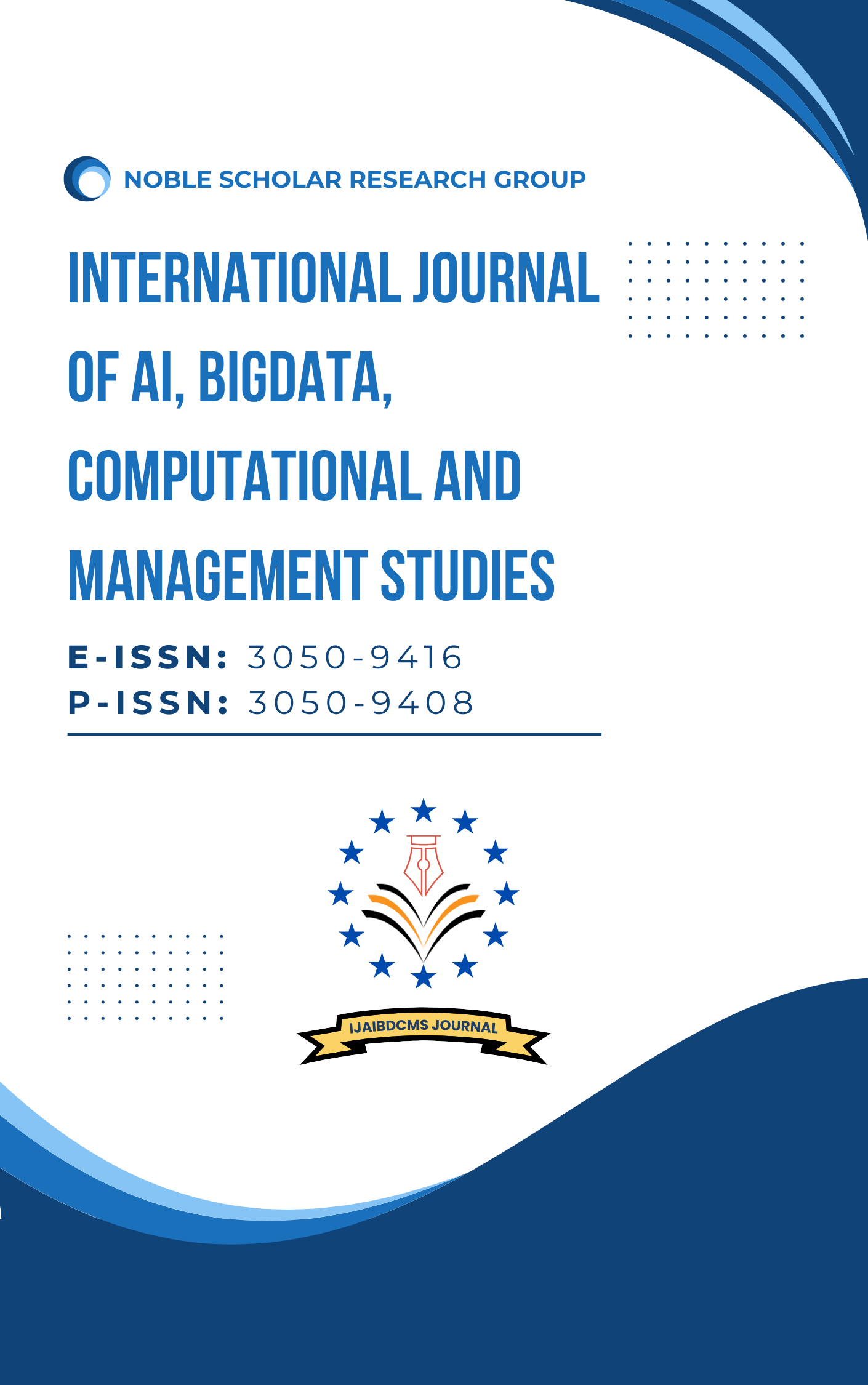AI Risk Coverage: Designing New Products to Cover Liability from AI Model Failures or Biased Algorithmic Decisions
DOI:
https://doi.org/10.63282/3050-9416.IJAIBDCMS-V4I1P114Keywords:
Artificial Intelligence, AI Risk, Algorithmic Bias, Model Failures, Liability Insurance, Risk Management, Insurance Product DesignAbstract
Artificial Intelligence (AI) is rapidly finding its application in the industries, with appropriate opportunity and threats. The failures of AI models and the bias on the algorithms are regarded as those issues, which are highly important to the company and can lead to financial losses, fines, and statistical annihilation of the image. This paper is going to explore the development of insurance product and risk management strategies that would mitigate their liabilities in case of AI errors. The article is devoted to the awareness of the nature of the AI risks, the evaluation of the potential financial impact, and the new models of covers related to the AI risks. Systematic methodology where risk assessment frameworks, actuarial models and scenario analysis frameworks are implemented is adopted to measure the potential liabilities. The paper will also review the existing literature alongside a review of some of the literature that has been done on biases detection and insurance mechanisms as well as AI failures. The results also indicate that the AI risk insurance products must involve the dynamic monitoring, periodic model auditing and the adaptive premium structure. Among the regulatory frameworks and the use of AI in an ethical manner and technological protection, as explained in the discussion, the area that has a great impact on the coverage of AI risks. The paper is important to the academic discussions and practical answers to the policies which underwriters employ to reduce the rising perils of AI by presenting ideas on how the policies are to be shaped, how the policies affect the formation and also the extent to which the policies are adopted in the industry
References
[1] Gerke, S., Minssen, T., & Cohen, G. (2020). Ethical and legal challenges of artificial intelligence-driven healthcare. In Artificial intelligence in healthcare (pp. 295-336). Academic Press.
[2] Karri, N. (2021). Self-Driving Databases. International Journal of Emerging Trends in Computer Science and Information Technology, 2(1), 74-83. https://doi.org/10.63282/3050-9246.IJETCSIT-V2I1P10
[3] Lior, A. (2021). Insuring AI: The role of insurance in artificial intelligence regulation. Harv. JL & Tech., 35, 467.
[4] Swanson, G. (2018). Non-autonomous artificial intelligence programs and products liability: how new AI products challenge existing liability models and pose new financial burdens. Seattle UL Rev., 42, 1201.
[5] Chagal-Feferkorn, K. A. (2019). Am I an algorithm or a product: when products liability should apply to algorithmic decision-makers. Stan. L. & Pol'y Rev., 30, 61.
[6] Martin, K. (2019). Designing ethical algorithms. MIS Quarterly Executive.
[7] Banerjee, D. N., & Chanda, S. S. (2020). AI failures: A review of underlying issues. arXiv preprint arXiv:2008.04073.
[8] Karri, N., Pedda Muntala, P. S. R., & Jangam, S. K. (2025). Predictive Performance Tuning. International Journal of Emerging Research in Engineering and Technology, 2(1), 67-76. https://doi.org/10.63282/3050-922X.IJERET-V2I1P108
[9] Zuiderveen Borgesius, F. (2018). Discrimination, artificial intelligence, and algorithmic decision-making. Council of Europe, Directorate General of Democracy, 42.
[10] Karri, N., Pedda Muntala, P. S. R., & Jangam, S. K. (2022). Forecasting Hardware Failures or Resource Bottlenecks Before They Occur. International Journal of Emerging Research in Engineering and Technology, 3(2), 99-109. https://doi.org/10.63282/3050-922X.IJERET-V3I2P111
[11] Kordzadeh, N., & Ghasemaghaei, M. (2022). Algorithmic bias: review, synthesis, and future research directions. European Journal of Information Systems, 31(3), 388-409.
[12] Zekos, G. I. (2021). AI risk management. In Economics and Law of Artificial Intelligence: Finance, Economic Impacts, Risk Management and Governance (pp. 233-288). Cham: Springer International Publishing.
[13] Žigienė, G., Rybakovas, E., & Alzbutas, R. (2019). Artificial intelligence based commercial risk management framework for SMEs. Sustainability, 11(16), 4501.
[14] Karri, N., & Pedda Muntala, P. S. R. (2022). AI in Capacity Planning. International Journal of AI, BigData, Computational and Management Studies, 3(1), 99-108. https://doi.org/10.63282/3050-9416.IJAIBDCMS-V3I1P111
[15] Zhang, Y., Wu, S., Dai, E., Liu, D., & Yin, Y. (2008). Identification and categorization of climate change risks. Chinese Geographical Science, 18(3), 268-275.
[16] Morgan, M. G., Florig, H. K., DeKay, M. L., & Fischbeck, P. (2000). Categorizing risks for risk ranking. Risk analysis, 20(1), 49-58.
[17] Rakonjac, I., & Spasojević Brkić, V. (2018). Identifying and Categorizing Risks of New Product Development in a Small Technology-Driven Company. In Technology Entrepreneurship: Insights in New Technology-Based Firms, Research Spin-Offs and Corporate Environments (pp. 71-98). Cham: Springer International Publishing.
[18] Karri, N., Jangam, S. K., & Pedda Muntala, P. S. R. (2022). Using ML Models to Detect Unusual Database Activity or Performance Degradation. International Journal of Artificial Intelligence, Data Science, and Machine Learning, 3(3), 102-110. https://doi.org/10.63282/3050-9262.IJAIDSML-V3I3P111
[19] Radu, L. (2009). Qualitative, semi-quantitative and, quantitative methods for risk assessment: case of the financial audit. Analele Ştiinţifice ale Universităţii» Alexandru Ioan Cuza «din Iaşi. Ştiinţe economice, 56(1), 643-657.
[20] Giudici, P. (2018). Fintech risk management: A research challenge for artificial intelligence in finance. Frontiers in Artificial Intelligence, 1, 1.
[21] Riikkinen, M., Saarijärvi, H., Sarlin, P., & Lähteenmäki, I. (2018). Using artificial intelligence to create value in insurance. International Journal of Bank Marketing, 36(6), 1145-1168.
[22] Keller, B. (2020). Promoting responsible artificial intelligence in insurance. Geneva Association-International Association for the Study of Insurance Economics.
[23] Karri, N., & Pedda Muntala, P. S. R. (2022). AI in Capacity Planning. International Journal of AI, BigData, Computational and Management Studies, 3(1), 99-108. https://doi.org/10.63282/3050-9416.IJAIBDCMS-V3I1P111
[24] Kiener, M. (2021). Artificial intelligence in medicine and the disclosure of risks. AI & society, 36(3), 705-713.
[25] Bécue, A., Praça, I., & Gama, J. (2021). Artificial intelligence, cyber-threats and Industry 4.0: Challenges and opportunities. Artificial intelligence review, 54(5), 3849-3886.



